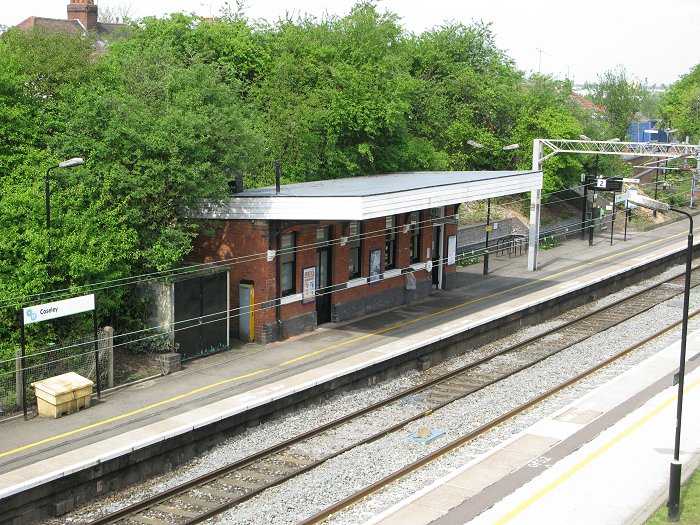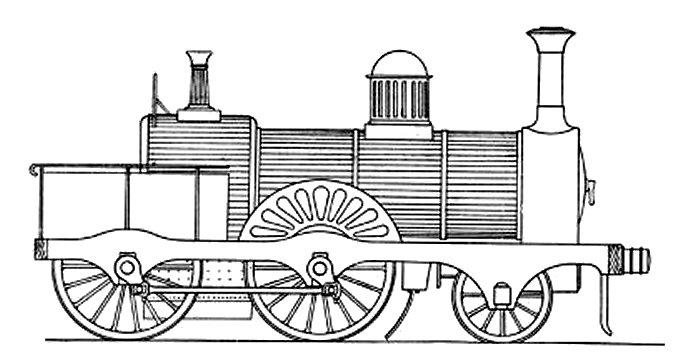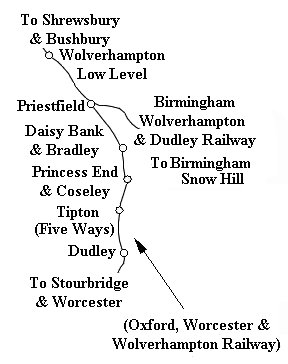|
Railways
The London &
North Western Railway
Coseley railway station is on
the Stour Valley Line, which was originally known as
the Birmingham, Wolverhampton & Stour Valley
Railway. Construction of the line was authorised
under the terms of an Act of Parliament passed on
the 3rd August, 1846. The line had seven
intermediate stations, located at Smethwick, Spon
Lane, Oldbury, Dudley Port, Tipton, Coseley, and
Ettingshall Road. After the service had been
established, stations were added at Bushbury, Albion
(near Oldbury), Monument Lane, and Monmore Green.
It became known as the Stour
Valley Line because of a projected line from
Smethwick to Stourbridge, which never materialised.
Wolverhampton High Level Station and the section to
Bushbury belonged jointly to the London & North
Western Railway and the Shrewsbury & Birmingham
Railway, under the terms of an Act of Parliament
passed on the 9th July, 1847. This gave both railway
companies running powers over the line, in which
they had both equally invested. |
|

Canals, railways and
Birmingham New Road. |
|
The line was to start at
Birmingham New Street station, which was
initially known as Navigation Street Station,
until its name changed on the timetables in
November 1852. The route was to run from the
London & Birmingham line at New Street Station
to Bushbury, where it would join the Grand
Junction Railway.
The chief engineers were
Robert Stephenson and William Baker.
Construction quickly began at the Birmingham end,
on the 845 yard tunnel into New Street Station.
The line was completed on the 21st November,
1851. It had taken just over four years to
build. The Shrewsbury & Birmingham Railway
expected to start running trains into Birmingham
in December 1851, but the London & North Western
had other ideas.
On the 10th January, 1851,
the Shrewsbury & Birmingham signed a traffic
agreement with the London & North Western’s
rival, the Great Western Railway, which led to
an offer to amalgamate in 1856 or 57. The London
& North Western heard about this and so invoked
their 1847 agreement and denied access to the
Shrewsbury & Birmingham Railway, which led to a
bitter dispute.
Agreement was finally
reached in 1854 and Shrewsbury & Birmingham
trains started to run to Birmingham, but the
London & North Western had set a high fixed rent
for S & B trains using New Street Station. The S
& B finally joined the Great Western Railway on
the 1st September, 1854, but continued to run
their trains on the Stour Valley line until
November of that year.
On the 1st February, 1852,
the line was opened for London & North Western
goods, and from the 1st March, 1853, a half
hourly service started from Wolverhampton to
Birmingham which was designed to prevent the
Shrewsbury & Birmingham from gaining access. The
London & North Western claimed that due to the
frequent service it would now be dangerous for
Shrewsbury & Birmingham trains to run alongside
their own.
Once the Shrewsbury &
Birmingham had departed, the line became a great
success. In the 1870's as many as 120 passenger
trains and 50 goods trains ran daily in and out
of Wolverhampton. |
|

Coseley railway
station. |
|

A close up view of the
old part of Coseley railway station. |
|
The original Deepfields and
Coseley station, as marked on the 1884 and 1901
Ordnance Survey maps was located on the northern
side of the railway bridge over Darkhouse Lane.
In 1902 it moved to its current
location. In 1896 the station master was William
Tatton, and in 1912 it was William Lyons. The
agent in 1912 was Benjamin George Firkin.
The line became a great
success. By the 1870s around 120 passenger
trains and 50 goods trains ran daily in and out
of Wolverhampton High Level Station.

An old London & North
Western Railway postcard. |
|
The
Great Western Railway
The other railway that
passed through Coseley was run by the Great
Western Railway, although it started life as
part of the Oxford, Worcester &
Wolverhampton Railway, or ‘old worse and
worse’ as it was known.
The Great Western
Railway was originally founded to provide a
route from Bristol to London, using broad
gauge track, as developed by its chief
engineer I. K. Brunel. It wasn't long before
its sights turned northwards due to the
success of its standard gauge rivals, the
Grand Junction Railway, and the London &
Birmingham Railway.
The GWR actively
encouraged any broad gauge railway company
that had set its sights on alternative
routes to the midlands and the north. One
such company was the Oxford, Worcester &
Wolverhampton Railway. The GWR agreed to
provide three and a half percent of its
capital.
On the 4th August, 1845
a Bill was passed that authorised the
company to construct a line from the Oxford
& Rugby Railway at Wolvercot Junction to
Worcester, Stourbridge, Dudley, and
Wolverhampton, with a branch to the Grand
Junction Railway at Bushbury. Other branches
included lines to Kingswinford, and Tipton
Basin.
The Bill was passed in
the middle of the gauge wars and so it
stated that the track was to be mixed gauge
from Abbotswood near Worcester, northwards.
It also stated that if the Oxford, Worcester
& Wolverhampton failed to complete the line,
the Great Western should either lease the
line, or purchase the company and complete
the line itself. The Bill also stated that
Wolverhampton Low Level Station was to be
constructed and run jointly with two other
companies; the Shrewsbury & Birmingham
Railway and the Birmingham, Wolverhampton &
Dudley Railway.
Brunel's estimate for the
cost was one and a half million pounds, but
it was quickly realised that it would
actually cost an extra million pounds
or so. Due to this, the Great Western
increased their share to four percent.

Engine No.
21. Oxford, Worcester & Wolverhampton
Railway.
Progress was slow and
by the 1st June, 1849 all of the available
money had been spent. Only the middle
section of the line was anywhere near
complete, so the Railway Commissioners
ordered the Great Western to complete the
line. They refused, and a legal battle
started. Meanwhile the loyalty of the
Oxford, Worcester & Wolverhampton towards
the Great Western began to decline. An
agreement with the London & North Western
and the Midland Railway was signed on the
21st February, 1851, which allowed those
companies to finish the line themselves, and
then run on it.
The Great Western was
furious and had the agreement made void,
then offered the company a similar deal on
their own terms. The Great Western leased
the line, but the ungrateful Oxford,
Worcester & Wolverhampton made approaches to
the London & North Western to reach
Wolverhampton on the Stour Valley line with
a junction at Tipton. The GWR protested to
Parliament, who refused to sanction such a
thing and threatened the company with heavy
penalties unless the line reached the Low
Level station and Cannock Road Junction by
September 1853. |
 |
The section from Evesham to Stourbridge
opened on the 3rd May, 1852, but as
little money was available, six second-hand
locomotives had to be acquired. The
Stourbridge to Dudley section opened to
goods traffic on the 16th November, 1852,
and to passenger traffic on the 20th
December, 1852. By this time the company had
ordered twenty locomotives from R and W
Hawthorn Limited, at Newcastle upon Tyne.
On the 4th June, 1853, the section from Wolvercot Junction and Evesham opened, and
on the 1st December, 1853, the line opened
between Dudley and Tipton. Tipton was later
called Tipton Five Ways to avoid confusion
with the station in Owen Street.
There were four intermediate stations
between Tipton and Wolverhampton: Princes
End, Daisey Bank (later called Daisy Bank),
Bilston, and Priestfield. The line was
eventually finished in July 1853, and opened
on 1st December. |
|
By August 1862, eleven
trains ran daily from Wolverhampton to
Oxford, the fastest time being 3hrs 25mins.
There were also trains to Evesham, Worcester
and Dudley. In 1896 the station master at
Daisy Bank was Clement Mole. In 1912 it was
William Tomalin. The station master at
Princes End in 1912 was Raymond W. Hermon.
Tipton Five Ways
Station eventually closed in 1962, though
the line remained open until 22nd September,
1968. The station buildings were soon
demolished. |
 |
|
 |
|
 |
Return to
Canals |
|
Return to
the
Contents |
|
Proceed to
Roads |
|